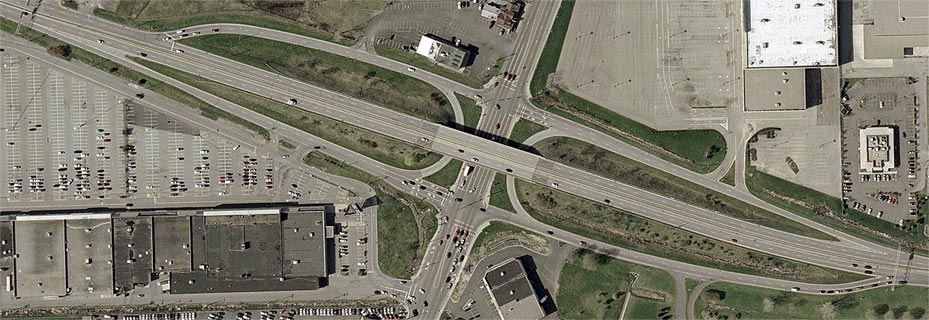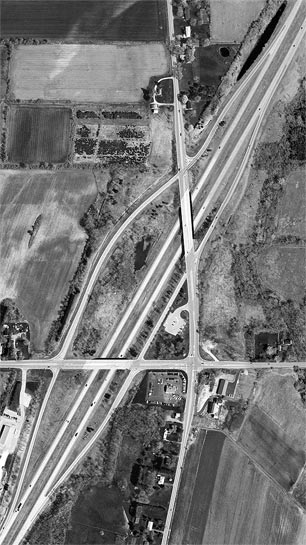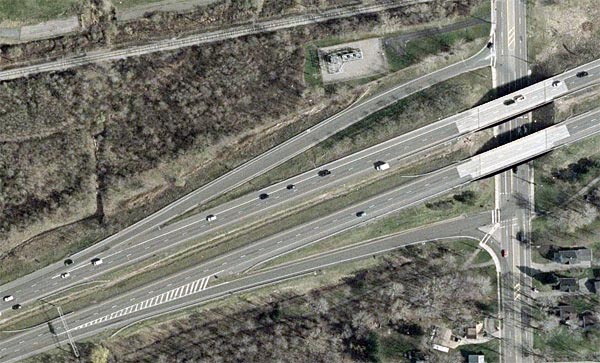Monday, 22 September 2003
 |
 |
The most basic interchange form is the diamond, a four-ramp configuration used where the freeway meets a relatively low-traffic surface road. The example shown above is the NY 531 freeway at NY 259 (Union Street) near Spencerport. The ramp widths and allocation of turning lanes in this example favor traffic between points north (Spencerport) and east (Rochester).
 |
Diamond interchanges are as common in urban areas as rural. In urban areas, however, space is usually limited, and the urban diamond interchange is usually more compact. In this case, Interstate 490 (Exit 19) at Culver Road in Rochester, the ramps ride directly alongside the freeway on vertical concrete retaining walls. Although this interchange handles far more traffic than the rural example, it has narrower ramps and fewer turning lanes. As a result, Culver Road between the interchange ramps is often choked with traffic. A modern design that solves this problem (and might be appropriate at this location) is the Single Point Urban Interchange or SPUI.
 Sometimes
in urban areas a diamond interchange will intermingle with nearby
streets. At Exit 18 (right), I-490 meets NY
31 (Monroe Avenue) at an interchange very similar to Exit 19. However,
Field Street (bottom, left of center) joins the eastbound exit ramp
before
meeting Monroe Avenue. Therefore, the end of the offramp is a
two-way divided road, to allow a full connection between Field Street
and Monroe Avenue. As well, Pembroke Street
(bottom left) meets Field Street immediately alongside the offramp.
Sometimes
in urban areas a diamond interchange will intermingle with nearby
streets. At Exit 18 (right), I-490 meets NY
31 (Monroe Avenue) at an interchange very similar to Exit 19. However,
Field Street (bottom, left of center) joins the eastbound exit ramp
before
meeting Monroe Avenue. Therefore, the end of the offramp is a
two-way divided road, to allow a full connection between Field Street
and Monroe Avenue. As well, Pembroke Street
(bottom left) meets Field Street immediately alongside the offramp.
 At
left is an example of a non-freeway diamond interchange in the Town of
Henrietta. Here, NY 252 (left to right) crosses over NY 15 in a busy
retail area. The ramps entering NY 252, two lanes wide, are controlled
by traffic signals, with both lanes feeding directly into the divided
highway. Note that the ramps also serve adjoining properties, and to
provide left turn movements from these areas, the interchange features
"Texas U-turns" on either side of NY 15.
At
left is an example of a non-freeway diamond interchange in the Town of
Henrietta. Here, NY 252 (left to right) crosses over NY 15 in a busy
retail area. The ramps entering NY 252, two lanes wide, are controlled
by traffic signals, with both lanes feeding directly into the divided
highway. Note that the ramps also serve adjoining properties, and to
provide left turn movements from these areas, the interchange features
"Texas U-turns" on either side of NY 15.
 When a freeway crosses two closely-spaced surface
roads, an extended diamond can be used. At
right is Exit 11 on Interstate 390, where the freeway crosses NY 251
(left to right) and NY 15 in the Town of Rush. In this case, since the
two surface roads intersect each other, the interchange provides some
redundant connections between them.
When a freeway crosses two closely-spaced surface
roads, an extended diamond can be used. At
right is Exit 11 on Interstate 390, where the freeway crosses NY 251
(left to right) and NY 15 in the Town of Rush. In this case, since the
two surface roads intersect each other, the interchange provides some
redundant connections between them.
 A half diamond (left) is used where traffic patterns
require a connection in one direction only, or as a supplement to a
nearby interchange. This interchange, NY 104 at Phillips Road in
Webster, primarily serves traffic between the Rochester area to the
west, and a major plant of the Xerox Corporation on Phillips Road.
A half diamond (left) is used where traffic patterns
require a connection in one direction only, or as a supplement to a
nearby interchange. This interchange, NY 104 at Phillips Road in
Webster, primarily serves traffic between the Rochester area to the
west, and a major plant of the Xerox Corporation on Phillips Road.
Half diamonds are often used in pairs with parallel surface streets.
Such a pair exists on I-590 at
Exit 3 (Elmwood Avenue) and Exit 4 (Highland Avenue). This has the
effect of providing full access to a
residential area without encouraging much on-and-off traffic activity.
A very rare type of half diamond provides ramps on and off in the same direction (on only one side of the freeway), instead of the usual offramp in one direction and onramp in the other.
Other examples
showing further variations
Week 6 (diamond with traffic circle and
U-turns)
Week 7 (overlapped diamond)
Week 8 (half diamond)
Week 13 (modified diamond)
Week 16 - Exit 6A (modified extended diamond)
Week 21 - Exit 7 (half diamond)
Week 24 (urban half diamond)
Week 28 (overlapped diamond)
Week 29 (modified half diamond)
Week 30 (half diamond)
Week 36 - Exit 14B (diamond)
Week 47 (extended diamond)
Week 50 (interior diamond)